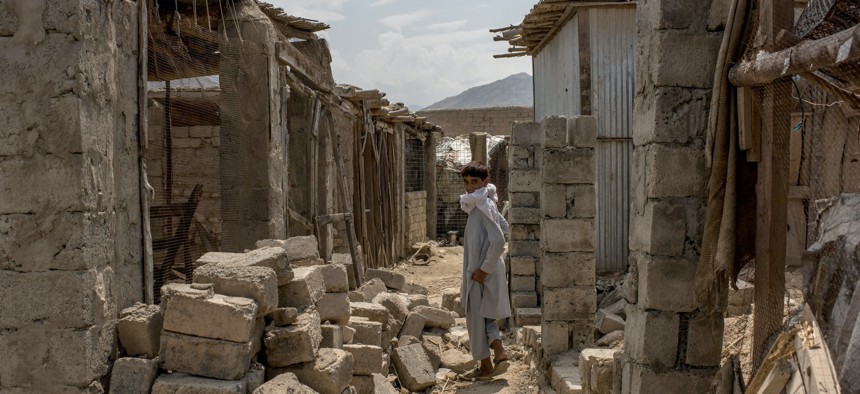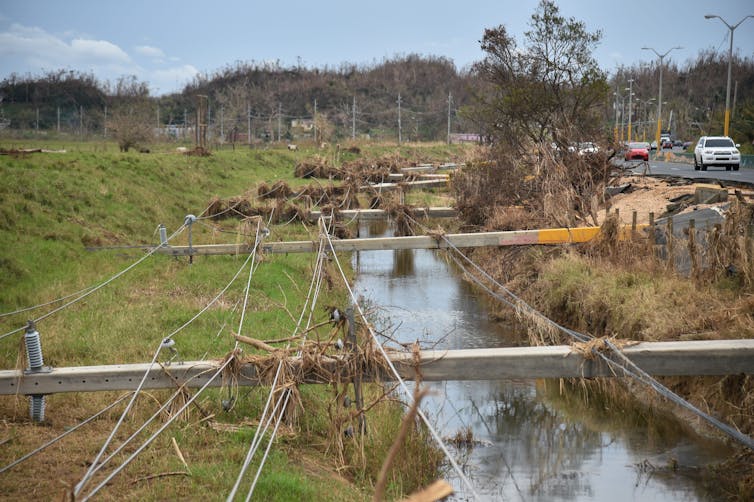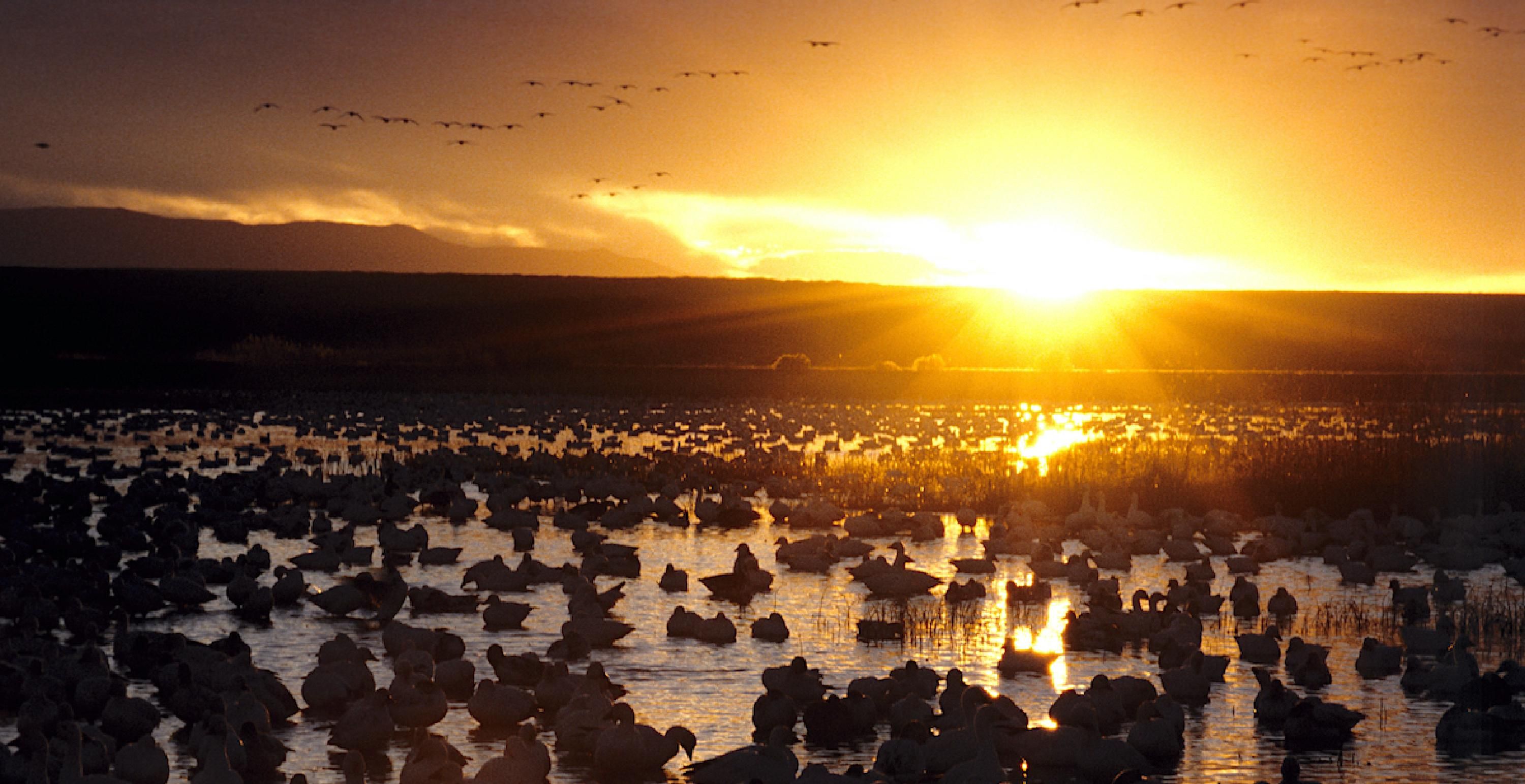
New Zealand's new carbon-cutting climate plans have been slammed by environmental groups for not doing enough on emissions from agriculture
William WEST AFP/File
Issued on: 13/10/2021 -
Wellington (AFP)
New Zealand put forward a raft of carbon-cutting plans Wednesday, ranging from reduced car usage to making ebikes more accessible to meet its target of becoming carbon-zero by 2050.
But the proposals, which come ahead of the COP26 climate meeting of world leaders in Glasgow at the end of this month and are a forerunner to the government's emissions reduction plan next May, drew immediate criticism.
New Zealand is under pressure to do more to curb carbon emissions, which are increasing, but the discussion document made little mention of agriculture which contributes 48 percent of its greenhouse gas emissions.
Environmental group Greenpeace said the document was "full of meaningless waffle" that did little to broach the conversation on reducing agricultural emissions.
Climate activists Generation Zero called it a "disgrace" that failed to meet "unambitious emissions budgets, completely ignores agriculture -- which makes up half of our emissions".
However, Climate Change Minister James Shaw said there was "an entire work program" dealing with the agricultural sector and "we didn't want to waste people's time by including things that have either already been consulted on or have other kind of engagement processes elsewhere."
Prime Minister Jacinda Ardern said the plans would reduce emissions and "can also create jobs and new opportunities for Kiwi businesses and our economy".
The document comes almost two years after New Zealand passed its Zero Carbon Act and a year after it declared a climate emergency.
Ardern has previously described action on climate change as a matter of "life or death" but has been called out by Swedish environmental activist Greta Thunberg, who accused New Zealand of being "one of the world's worst performers" on emission increases.
"People believe Jacinda Ardern and people like that are climate leaders," Thunberg said last month.
"That just tells you how little people know about the climate crisis. Obviously, the emissions haven't fallen. It goes without saying that these people are not doing anything."
Many of the initiatives contained in the discussion document are from the Climate Change Commission report presented to the government earlier this year, including a 20 percent reduction in the use of cars by 2035.
In the same period, it wants to reduce emissions from transport fuels by 15 percent, make public transport cheaper and more accessible, and introduce incentives for those on low incomes to buy electric vehicles.
Other ideas include the development of low-emission fuels, such as bioenergy and hydrogen, eliminating the use of fossil gas, reducing food waste and encouraging composting.
© 2021 AFP
Issued on: 13/10/2021 -
Wellington (AFP)
New Zealand put forward a raft of carbon-cutting plans Wednesday, ranging from reduced car usage to making ebikes more accessible to meet its target of becoming carbon-zero by 2050.
But the proposals, which come ahead of the COP26 climate meeting of world leaders in Glasgow at the end of this month and are a forerunner to the government's emissions reduction plan next May, drew immediate criticism.
New Zealand is under pressure to do more to curb carbon emissions, which are increasing, but the discussion document made little mention of agriculture which contributes 48 percent of its greenhouse gas emissions.
Environmental group Greenpeace said the document was "full of meaningless waffle" that did little to broach the conversation on reducing agricultural emissions.
Climate activists Generation Zero called it a "disgrace" that failed to meet "unambitious emissions budgets, completely ignores agriculture -- which makes up half of our emissions".
However, Climate Change Minister James Shaw said there was "an entire work program" dealing with the agricultural sector and "we didn't want to waste people's time by including things that have either already been consulted on or have other kind of engagement processes elsewhere."
Prime Minister Jacinda Ardern said the plans would reduce emissions and "can also create jobs and new opportunities for Kiwi businesses and our economy".
The document comes almost two years after New Zealand passed its Zero Carbon Act and a year after it declared a climate emergency.
Ardern has previously described action on climate change as a matter of "life or death" but has been called out by Swedish environmental activist Greta Thunberg, who accused New Zealand of being "one of the world's worst performers" on emission increases.
"People believe Jacinda Ardern and people like that are climate leaders," Thunberg said last month.
"That just tells you how little people know about the climate crisis. Obviously, the emissions haven't fallen. It goes without saying that these people are not doing anything."
Many of the initiatives contained in the discussion document are from the Climate Change Commission report presented to the government earlier this year, including a 20 percent reduction in the use of cars by 2035.
In the same period, it wants to reduce emissions from transport fuels by 15 percent, make public transport cheaper and more accessible, and introduce incentives for those on low incomes to buy electric vehicles.
Other ideas include the development of low-emission fuels, such as bioenergy and hydrogen, eliminating the use of fossil gas, reducing food waste and encouraging composting.
© 2021 AFP
The AP Interview: James Shaw wants climate talks to deliver
By NICK PERRY

1 of 6

New Zealand's climate scientist James Renwick speaks in his office in Wellington, New Zealand, Wednesday Oct. 13, 2021. The coronavirus pandemic has shown that humans are very good at responding to an immediate crisis, says New Zealand's Climate Change Minister James Shaw. But when it comes to dealing with a slower-moving threat like climate change, he says, we're "terribly bad." Renwick said he thinks New Zealand and other nations need to bring more urgency to their actions. (AP Photo/Sam James)
“The countries of the world have talked about this issue for many years, but we still haven’t really seen the action, and time has got extremely short now,” said Renwick, a professor at the Victoria University of Wellington. “We’ve got to see emissions reduction starting immediately, 2022, and we have to get emissions down really fast in the next decade.”
Almost half of New Zealand’s greenhouse gas emissions come from agriculture — think millions of cows burping methane gas — in an economy that relies on exporting food. Many environmentalists say farmers are essentially getting a free pass from lawmakers.
Shaw said farmers will be subject to new emissions rules that will come into effect by 2025, and that many are finding innovative ways to reduce their carbon footprints.
He said an important part of his trip to Glasgow will be to stand alongside colleagues from low-lying Pacific islands who are already feeling extensive effects from climate change through more severe cyclones and rising sea levels.
He said the Cook Islands, for instance, spends about a quarter of its national budget on mitigating the effects of climate change.
Shaw acknowledges the irony that thousands of people from around the world will be burning many tons of fossil fuels to fly to Glasgow for the talks.
“Unfortunately, it’s the only way that we can practically get there and proactively participate,” Shaw said.
Renwick said that aspect didn’t bother him too much.
“We all live in the world we live in, the one that’s been created over the last century or more,” Renwick said. “I think it’s just the way it is. You have to burn a bit of fossil fuel to work out how to stop doing that.”
By NICK PERRY

1 of 6
New Zealand's Climate Change Minister James Shaw speaks during an interview with The Associated Press in his office in Wellington, New Zealand, Wednesday, Oct. 13, 2021. The coronavirus pandemic has shown that humans are very good at responding to an immediate crisis, says Shaw. But when it comes to dealing with a slower-moving threat like climate change, he says, we're "terribly bad." (AP Photo/Sam James)
WELLINGTON, New Zealand (AP) — The coronavirus pandemic has shown that humans are very good at responding to an immediate crisis, says New Zealand’s Climate Change Minister James Shaw. But when it comes to dealing with a slower-moving threat like climate change, he says, we’re “terribly bad.”
Shaw spoke to The Associated Press on Wednesday ahead of a key climate summit that starts in Glasgow, Scotland, on Oct. 31. Many environmentalists say the U.N. summit, known as COP26, represents the world’s final chance to avert a climate catastrophe.
Shaw said that at Glasgow, he intends to announce a more ambitious target for New Zealand’s emissions reductions over the coming decade, and he hopes many other countries also aim higher.
He said a top priority will be to ensure that a promise made by wealthier nations to provide $100 billion a year to help poorer countries switch to cleaner energy is fulfilled.
“The developed world so far has not delivered on that promise,” Shaw said.
That has led to a breakdown in trust and a fraying of the consensus reached with the 2015 Paris Agreement, he said. It’s also giving an excuse to authoritarian regimes to disrupt international cooperation, he added.
Shaw said the pandemic had accelerated the transition to cleaner energy in some countries. But in many developing nations it had slowed improvements, he said, because they were struggling simply to cope with the massive financial and social impacts from the disease.
Shaw said he has doubts whether some of the positive environmental changes made by people during the pandemic — like working from home more and driving less — will endure.
“I think those are possibilities, but I also think human beings tend to revert to type,” Shaw said. “I know when we’re in the middle of it, it feels like the world has changed fundamentally.”
New Zealand’s government has promised the country will become carbon-neutral by 2050. But it has also faced criticism for talking a lot about climate change and not taking action quickly enough. Greenhouse gas emissions in the nation of 5 million reached an all-time high just before the pandemic hit.
Shaw said lawmakers have passed many new bills in recent years that will have a positive impact over time, including a ban on new offshore oil and gas exploration, tougher emissions standards for cars, a subsidy scheme for electric vehicles, and the establishment of a climate change commission.
“Is it enough? No. And the thing is, it never will be enough,” Shaw said. “We know that every single year, we are going to have to continue to take new and further actions on climate change because this is a multi-generational battle over the course of the next 30 years and beyond. It’s going to involve every part of our economy, every part of our society.”
Climate scientist James Renwick said he thinks New Zealand and other nations need to bring more urgency to their actions.
WELLINGTON, New Zealand (AP) — The coronavirus pandemic has shown that humans are very good at responding to an immediate crisis, says New Zealand’s Climate Change Minister James Shaw. But when it comes to dealing with a slower-moving threat like climate change, he says, we’re “terribly bad.”
Shaw spoke to The Associated Press on Wednesday ahead of a key climate summit that starts in Glasgow, Scotland, on Oct. 31. Many environmentalists say the U.N. summit, known as COP26, represents the world’s final chance to avert a climate catastrophe.
Shaw said that at Glasgow, he intends to announce a more ambitious target for New Zealand’s emissions reductions over the coming decade, and he hopes many other countries also aim higher.
He said a top priority will be to ensure that a promise made by wealthier nations to provide $100 billion a year to help poorer countries switch to cleaner energy is fulfilled.
“The developed world so far has not delivered on that promise,” Shaw said.
That has led to a breakdown in trust and a fraying of the consensus reached with the 2015 Paris Agreement, he said. It’s also giving an excuse to authoritarian regimes to disrupt international cooperation, he added.
Shaw said the pandemic had accelerated the transition to cleaner energy in some countries. But in many developing nations it had slowed improvements, he said, because they were struggling simply to cope with the massive financial and social impacts from the disease.
Shaw said he has doubts whether some of the positive environmental changes made by people during the pandemic — like working from home more and driving less — will endure.
“I think those are possibilities, but I also think human beings tend to revert to type,” Shaw said. “I know when we’re in the middle of it, it feels like the world has changed fundamentally.”
New Zealand’s government has promised the country will become carbon-neutral by 2050. But it has also faced criticism for talking a lot about climate change and not taking action quickly enough. Greenhouse gas emissions in the nation of 5 million reached an all-time high just before the pandemic hit.
Shaw said lawmakers have passed many new bills in recent years that will have a positive impact over time, including a ban on new offshore oil and gas exploration, tougher emissions standards for cars, a subsidy scheme for electric vehicles, and the establishment of a climate change commission.
“Is it enough? No. And the thing is, it never will be enough,” Shaw said. “We know that every single year, we are going to have to continue to take new and further actions on climate change because this is a multi-generational battle over the course of the next 30 years and beyond. It’s going to involve every part of our economy, every part of our society.”
Climate scientist James Renwick said he thinks New Zealand and other nations need to bring more urgency to their actions.

New Zealand's climate scientist James Renwick speaks in his office in Wellington, New Zealand, Wednesday Oct. 13, 2021. The coronavirus pandemic has shown that humans are very good at responding to an immediate crisis, says New Zealand's Climate Change Minister James Shaw. But when it comes to dealing with a slower-moving threat like climate change, he says, we're "terribly bad." Renwick said he thinks New Zealand and other nations need to bring more urgency to their actions. (AP Photo/Sam James)
“The countries of the world have talked about this issue for many years, but we still haven’t really seen the action, and time has got extremely short now,” said Renwick, a professor at the Victoria University of Wellington. “We’ve got to see emissions reduction starting immediately, 2022, and we have to get emissions down really fast in the next decade.”
Almost half of New Zealand’s greenhouse gas emissions come from agriculture — think millions of cows burping methane gas — in an economy that relies on exporting food. Many environmentalists say farmers are essentially getting a free pass from lawmakers.
Shaw said farmers will be subject to new emissions rules that will come into effect by 2025, and that many are finding innovative ways to reduce their carbon footprints.
He said an important part of his trip to Glasgow will be to stand alongside colleagues from low-lying Pacific islands who are already feeling extensive effects from climate change through more severe cyclones and rising sea levels.
He said the Cook Islands, for instance, spends about a quarter of its national budget on mitigating the effects of climate change.
Shaw acknowledges the irony that thousands of people from around the world will be burning many tons of fossil fuels to fly to Glasgow for the talks.
“Unfortunately, it’s the only way that we can practically get there and proactively participate,” Shaw said.
Renwick said that aspect didn’t bother him too much.
“We all live in the world we live in, the one that’s been created over the last century or more,” Renwick said. “I think it’s just the way it is. You have to burn a bit of fossil fuel to work out how to stop doing that.”






/cloudfront-ap-southeast-2.images.arcpublishing.com/nzme/JSGDJCQFKF3UE4TPUJWRIBXIKA.jpg)
/cloudfront-ap-southeast-2.images.arcpublishing.com/nzme/XRKCTUBMNVKIL2FH6EGJRHG6FM.jpg)
/cloudfront-ap-southeast-2.images.arcpublishing.com/nzme/723WURFU4SKEQOI7EWJJ4BUR44.jpg)
/cloudfront-ap-southeast-2.images.arcpublishing.com/nzme/EFL2NTUTW7LCQPTSRCOLMVUQFY.jpg)












